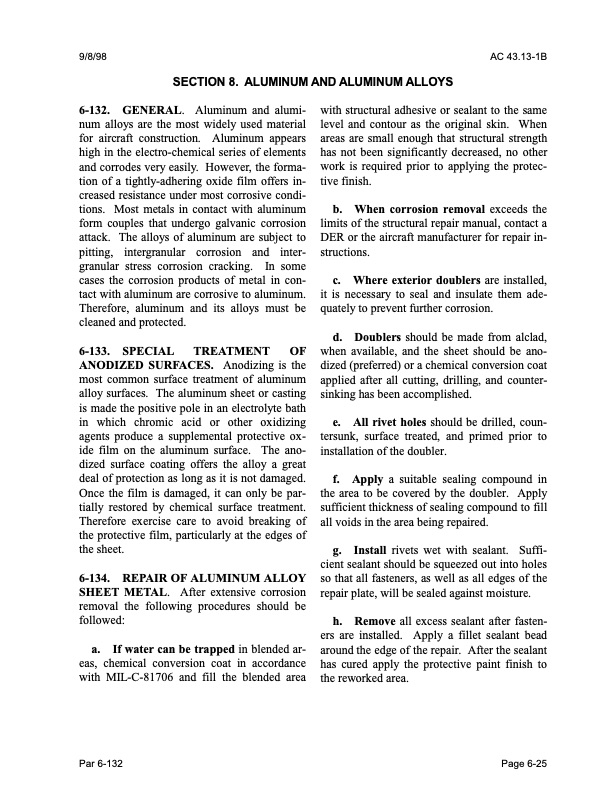
PDF Publication Title:
Text from PDF Page: 295
9/8/98 AC 43.13-1B SECTION 8. ALUMINUM AND ALUMINUM ALLOYS 6-132. GENERAL. Aluminum and alumi num alloys are the most widely used material for aircraft construction. Aluminum appears high in the electro-chemical series of elements and corrodes very easily. However, the forma tion of a tightly-adhering oxide film offers in creased resistance under most corrosive condi tions. Most metals in contact with aluminum form couples that undergo galvanic corrosion attack. The alloys of aluminum are subject to pitting, intergranular corrosion and inter- granular stress corrosion cracking. In some cases the corrosion products of metal in con tact with aluminum are corrosive to aluminum. Therefore, aluminum and its alloys must be cleaned and protected. 6-133. SPECIAL TREATMENT OF ANODIZED SURFACES. Anodizing is the most common surface treatment of aluminum alloy surfaces. The aluminum sheet or casting is made the positive pole in an electrolyte bath in which chromic acid or other oxidizing agents produce a supplemental protective ox ide film on the aluminum surface. The ano dized surface coating offers the alloy a great deal of protection as long as it is not damaged. Once the film is damaged, it can only be par tially restored by chemical surface treatment. Therefore exercise care to avoid breaking of the protective film, particularly at the edges of the sheet. 6-134. REPAIR OF ALUMINUM ALLOY SHEET METAL. After extensive corrosion removal the following procedures should be followed: a. If water can be trapped in blended ar eas, chemical conversion coat in accordance with MIL-C-81706 and fill the blended area with structural adhesive or sealant to the same level and contour as the original skin. When areas are small enough that structural strength has not been significantly decreased, no other work is required prior to applying the protec tive finish. b. When corrosion removal exceeds the limits of the structural repair manual, contact a DER or the aircraft manufacturer for repair in structions. c. Where exterior doublers are installed, it is necessary to seal and insulate them ade quately to prevent further corrosion. d. Doublers should be made from alclad, when available, and the sheet should be ano dized (preferred) or a chemical conversion coat applied after all cutting, drilling, and counter sinking has been accomplished. e. All rivet holes should be drilled, coun tersunk, surface treated, and primed prior to installation of the doubler. f. Apply a suitable sealing compound in the area to be covered by the doubler. Apply sufficient thickness of sealing compound to fill all voids in the area being repaired. g. Install rivets wet with sealant. Suffi cient sealant should be squeezed out into holes so that all fasteners, as well as all edges of the repair plate, will be sealed against moisture. h. Remove all excess sealant after fasten ers are installed. Apply a fillet sealant bead around the edge of the repair. After the sealant has cured apply the protective paint finish to the reworked area. Par 6-132 Page 6-25PDF Image | AFS-640

PDF Search Title:
AFS-640Original File Name Searched:
ac_43.13-1b_w-chg1.pdfDIY PDF Search: Google It | Yahoo | Bing
5,000 BF Shipping Container Lumber Dry Kiln For Quality Lumber The 5,000 BF container kiln consists of one 40 foot high-cube aluminum shipping container... More Info
Shipping Container Lumber Dry Kilns by Global Energy Global Energy designed and developed the container kiln back in 1991. The purpose is to give access to portable sawmill owners, furniture makers, and small business the value added profit of dry kiln lumber and quality hardwoods... More Info
Vacuum Kiln Conversion Kit for Lumber and Wood Dry Kilns Convert your existing conventional dry kiln into a fast drying vacuum kiln. Similar to vacuum bagging in the boat building and aircraft industry, we have come up with a proprietary process which allows you to build a very simple vacuum kiln at a fraction of the price, and without the intensive conventional metal chamber structure... More Info
Vacuum Pump Cart System for Bagging Clamping Wood Drying and more Vacuum Cart with 2HP Pump and Dual Pistons with multiple multiplex vacuum ports and liquid reservoir... More Info
Vacuum Bagging Basics Vacuum bagging is a method of clamping, which has traditionally been used in the composites industry, but can also be used for vacuum drying materials, including wood products... More Info
| CONTACT TEL: 608-238-6001 Email: greg@globalmicroturbine.com | RSS | AMP |